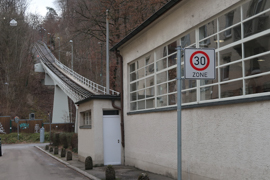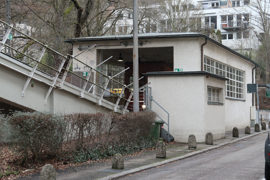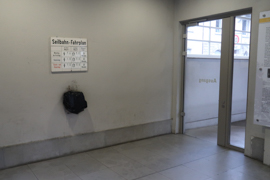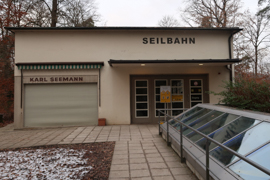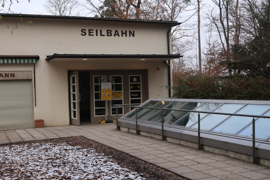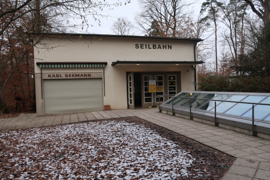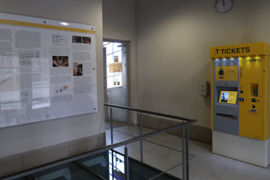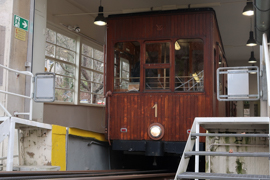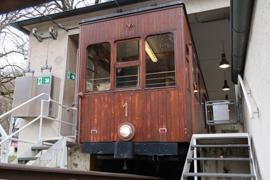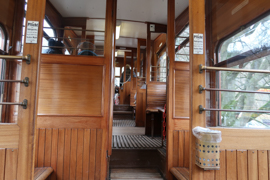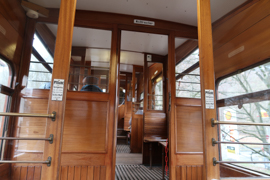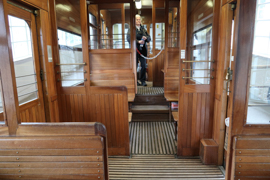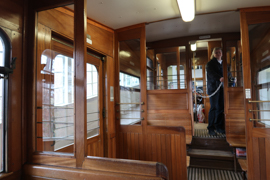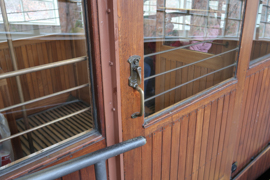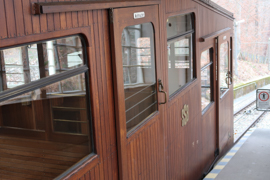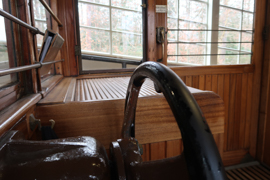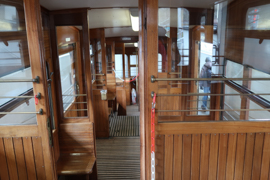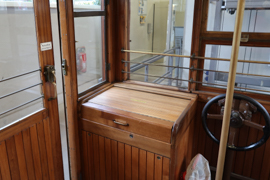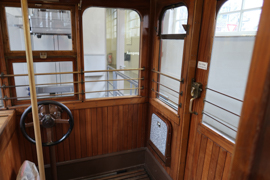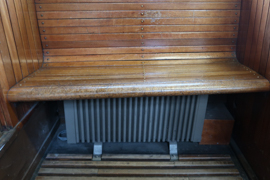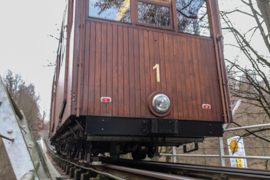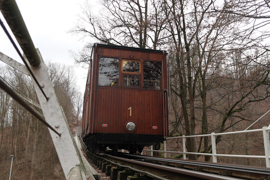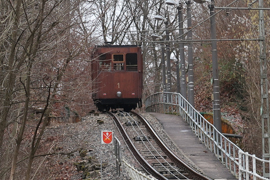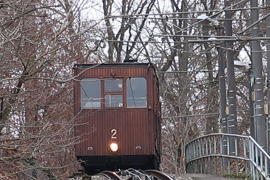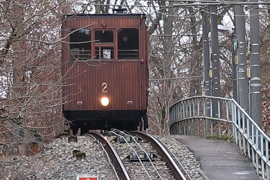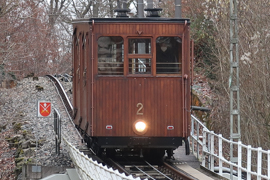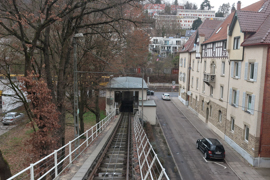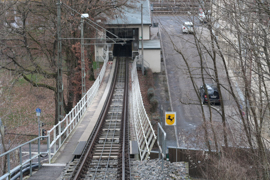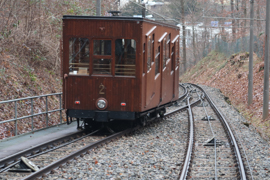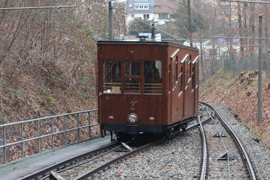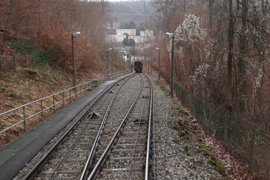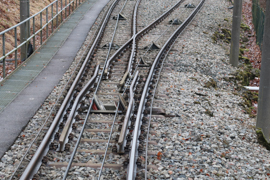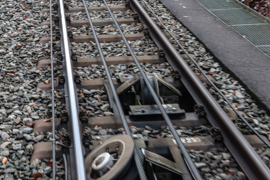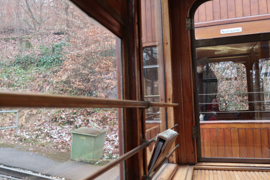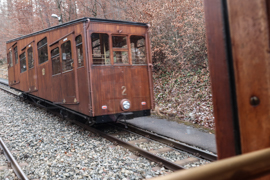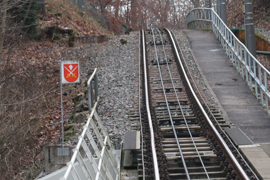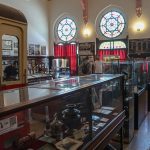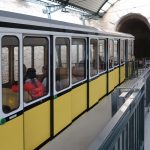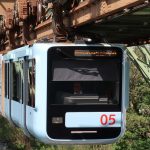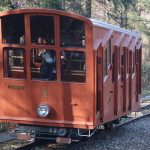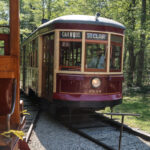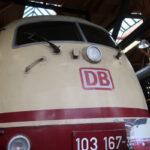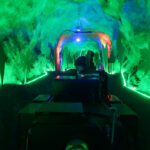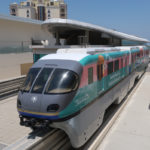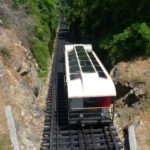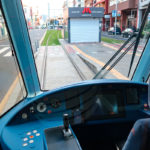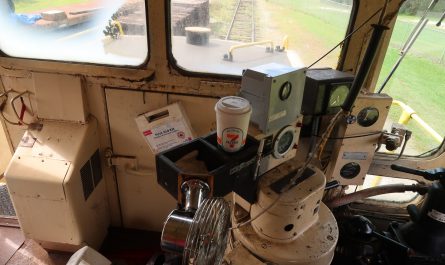Stuttgart Funicular
included in VVS fare
Flyctory.com Pros
- Iconic and historic-style public transport ride
- Included in Stuttgart's local traffic ticket
Flyctory.com Cons
- It's just about the ride - not too many sights uphill or around
Due to its rather hilly geography, the German city of Stuttgart has some quite iconic public transport systems. During a visit in January 2022, I had a look to the steepest rail operated by the local provider, the Stuttgart Funicular or Standseilbahn. Even though the ride is just some four minutes, a very fascinating experience. Here are my thoughts about the trip.

Stuttgart Funicular – Location & Fares
The Stuttgart Funicular is connecting the borough Heslach with the Forest Cemetery, which is located on a hill over the city. You can reach both stations by car. Especially close to the cemetery station, there is a major parking lot. As a tourist, however, you will likely take the underground / tram to the Südheimer Platz station. It is connected by three lines, U1, U9 and U34 and is just a few steps away from the lower terminus of the funicular. There are no other major attractions around, unfortunately.
Good news for historic transport fans: The Standseilbahn is indeed part of the Stuttgart local transport system VVS. It is listed as line #20 in the schedule. This also means that if you have a day ticket for the whole city (which is 5.40 EUR), the ride up and down the hill is for free (as often as you like). If you just like to ride the funicular, you need a KurzstreckenTicket (short distance ticket) for each ride, which is 1.50 EUR.
Stuttgart Funicular – The Route & Fare
The track length of the Stuttgart Funicular is 536m. In that distance, the climbs 87 meters and is thus the steepest trip on rails you can do as part of Stuttgart’s local transports. The Standseilbahn is operating every twenty minutes between 9:10 hrs and 17:50 hrs, daily. The travel time at a maximum speed of some 11km/h is roughly four minutes. Each station features ticket machines. Only while the wagons are moving, the access to the platform is blocked due to safety reasons.
The funicular was built to connect the cemetery. However, it finally took 14 years after the opening of the final resting places until the funicular finally became operational. In 2003, the engines of the systems got significantly renovated. You can see both engines, the historic and the new ones at the hill station. You only need 110 kW engine power to run the iconic public transport.








The two stations are rather simple. You may buy tickets at both stations at ticket machines. The cable car ride is the key attraction of the area, you may have some nice hikes or enjoy a drink and some cake at a cafe when you are uphill.








Stuttgart Funicular – The Rolling Stock
The traditional style funicular cars weigh some 8 metric tons each. Due to the cable car construction, the distance via the rope between the two cars is always constant. Both wagons are having an operator, which is always facing in the direction of travel. Only when both operators press a button, the rope is moving. The cars could carry some four tons of people or goods each – the in fact capacity might be slightly lower just due to the space. The design of the car stays traditional with a wooden touch.








I loved the interior of the wagons, which also gives a nice historic and nostalgic touch. There is heating in the cars, located underneath some of the seats. For these operational reasons, the cars are receiving electric energy by a contact wire. Due to Covid-19, the area, which is facing in the direction of travel, is blocked for the operator.




















Stuttgart Funicular – The Ride
It is definitely the ride as such and enjoying the technology, which is turning the Stuttgarter Standseilbahn to a great traveling experience. The trip and the area is not too overwhelming – I finally decided to go for a direct return after the some 15 minute resting period of the cable car. Especially the first meters after leaving the valley station is really steep and gives some nice view over the borough. However, the view over all Stuttgart is blocked by trees.












Here are some pictures from inside the ride. In order to be able to take snaps and due to the blocking for the operator, I sat on seats opposite to traveling direction. This means that the first pictures are from the uphill ride facing downwards and then the downhill ride looking into the opposite direction. The pictures also show nicely the difference between the thick hauling rope, which is in fact connecting the two trains for the operation over the uphill engine wheel, and the thinner opposite rope, which is competing the circular rope system via the valley station.

























Stuttgart Funicular – Services
Apart from the ticket machines, there are not too many services. You can grab an information brochure about this nice kind of transport, which I really liked. There is a public loo close to the cemetery station, which is, however, not operated by the Stuttgart Traffic System.
Stuttgart Funicular – My View
I love these kind of things – and I definitely recommend to have a ride with the Stuttgart Funicular. It is just nice technology, so easy to run it. The view is neither breathtaking en route nor on top, but it is just a great experience to do the trip. Last, but not least – it is practically free for most Stuttgart visitors, as you likely have some sort of ticket for Stuttgart local traffic anyway.
“Rides on Rail” Postings
Here is everything about trains, trams and other rail vehicles:

During my May 2025 trip to Istanbul, I did not do too much sightseeing. Quite a lot of stress at ...

My original plan for that Monday was to stay in Nashville and potentially have a look at the Rock n Jock celebrity ...

A late May 2025 trip gave me at least a short opportunity to explore the Turkish city Istanbul. I felt ...

On my trip to Bremen and Stockholm in May 2025, I had quite some time to spend before a Rock of ...

If I would have to name my favorite player I have seen playing for "my" Pittsburgh Penguins, this name would ...

I just had limited time in Indonesia during my October 2024 trip. Nonetheless, I definitely wanted to check out some ...

VR-Yhtymä Oyj Suomen Valtion Rautatiet - or "VR Cooperation Finnish State Railways" is the national railway company of Finland. While I ...

While in Vienna in January 2025, I did a bit of travel nerd things. Among other rail experiences, I was ...

I like public transport of all kinds. Thus, I was really happy that I finally made it to the Pennsylvania ...

After I shared my loyalty portfolio thoughts in March 2024 with you, it is time for an update. Especially the ...

The funicular railway Floibanen (or Fløibanen in Norwegian) is just 848 meter long, but is one of the most well-known ...

I am transportation nerd. Even though there is a certain touch of aviation in that regard on Flyctory.com, I do ...

With my recent mileage run and the trip to the World Floorball Championship Qualifications in Italy, I had quite a ...

While quite a lot of traveling is ahead of me during the next weeks, November and December 2024 was rather ...

has come to an end - and my Best of posting is the one which is "traditionally" concluding the year. The ...

Like I did in 2023, I will kick off my looking back to the year 2024 with some travel facts ...

While most of my lounge reviews deal with airport and airline lounges, I am always flattered to also visit lounge ...

While my 18th edition of the Food I Had Onboard just came with a limited number of trips rather widely ...

I really enjoy riding the Railjet. The type of trains is majorly the backbone of the Austrian high-speed rail network ...

17th October 2023 marked a very special day in the Indonesian and South-East Asian transportation history. The first ever high ...

What's a good way to explore the permanent fun fair and entertainment area in Vienna, the Prater, if you are ...

I did not have that much traveling during the last weeks - but as some major trips are ahead, I ...

Being the only guest in a lounge almost demands me having a lounge review. This happened to me in Dresden ...

Airport trains are a very convenient option to get to an airport. The Arlanda Express in Stockholm, for example, makes ...

After I already introduced you to the Dresden Suspension Cable Railroad (Schwebebahn), it is urgently time to share my other ...

Even though the Grand Central Terminal (or: Grand Central Station) in New York City is a popular touristic attraction, it ...

Oh, I traveled too much the last weeks again. Time for another Food I Had Onboard posting - this time also featuring ...

During a trip to Liege / Luik in Belgium, i took a short detour from a shopping mall to visit ...

67 kilometers alongside the Belgian Coast, serving 67 stations - the Kusttram ("Coastal tram line") is regarded to be the ...

The engine of the train states Se Norge. Ta Toget - or: "See Norway. From the train". Apart from the Flamsbanen, the Bergensbanen, ...

The Öresund Bridge connecting Copenhagen in Denmark and Malmö in Sweden revolutionized did not only revolutionize travel and transport between ...

In my fifteenth edition of my Food I Had Onboard posting series, I have a quhttps://flyctory.com/tag/deutschebahn/ite nice range of flight and ...

In early April 2023, I gave you an insight into my loyalty program strategy for 2023. The posting Thumbs up ...

According to Wikipedia, twelve different railroad lines overall operated from and through Kansas City overall. However, the golden age of ...

During our trip through Tokyo in September 2023, getting around the Japanese capital has been one of the key issues ...

Is it really New Year's Eve already again? The last day of the year? I am posting this one in ...

As you know, I am very interested in iconic public transport systems. Thus, I had to visit the Schwebebahn, the suspension ...

After my eleventh Food I Had Onboard posting majorly concentrated on two Lufthansa First Class legs between Frankfurt (FRA) and ...

TraMy trip in late October / early November 2023 involved a lot of traveling. Once I made it back to ...

If you solely take the ease of traveling as a criteria, I definitely took the wrong choice in regards of ...

The public transport situation of Dusseldorf Airport (DUS) is a bit more complex than it might feel at first sight ...

The Heathrow Express, the Elizabeth Line or the good, old Piccadilly Line - there are many transport options to get ...

After I introduced you to the amazing Florida high speed rail service Brightline already, this post is about about rail ...

Travelling to the very last Rock of Ages shows by the British DLAP production company brought me to Swansea in Wales. The ...

One more Food I had onboard until I have a full set of ten postings. Hope you also enjoy reading ...

The name of the German city of Wuppertal in the Bergische Land region near Cologne is indeed a perfect fit ...

With the introduction of Elizabeth Line, there is now a third option to get from Heathrow Airport (LHR) to the ...

For my trip from Manchester Airport (MAN) to Blackpool in February 2023, I was able to explore a new rail ...

Using public transport all over Germany for 49 Euro? Sounds like the perfect deal, especially if you are a visitor ...

Even though Heidelberg is a tourist magnet for many reasons, the Heidelberger Bergbahnen (Heidelberg Funiculars) are part of it. They offer you ...

The website states that the Nederlands Spoorwegmuseum (also: Het Spoowegmuseum) is the best train station in the Netherlands. In fact, the ...

In January 2023, I took a rail trip hitting all 16 German states in one day. Apart from that geographic ...

Especially when airports are located a little outside the city, airport express trains feel to be the perfect mass transportation ...

A major part of optimizing your travel portfolio is to determine the loyalty program which suits best to you. Thereby, ...

The last legs of the 2023 Weird Al Yankovic European Tour, Rock of Ages shows, the Pittsburgh Penguins and many ...

If you nowadays look at the map of Cyprus, you won't find any rail-driven vehicles. However, the country did have ...

Damn, it is already four years... And it is more than 2,750 postings since then. On 25th February 2018, I ...

Traveling by rail is typically a bit of an extra adventure: the reliability is low, compared to other European countries ...

Wow, it's already half a dozen of episodes. This time, I start my Food I Had Onboard posting with two ...

What a day - on 14th January 2023, I traveled through all 16 German states in a 24 hour train ...

AIthough has just been a day trip, but I just felt it is too long to tell the story of ...

Okay, I give in: this trip is weird. While people typically feel that I am "just" a die hard aviation ...

Even though people typically think that I am an aviation nerd "only", I am in general very interested in any ...

In previous postings, I already introduced you to my excellent travel experience with the Southern Florida high-speed rail provider Brightline ...

The last posting of the year - Best Ones 2022 is introducing you to my best experience last years (as ...

A trip to a Frequent Flyer meeting lead to a post about train rides: Less than two weeks after the ...

Even in the United States, you nowadays run into the green coaches of Flixbus. The company turned out to dominate ...

Especially when I visit large places for Flyctory.com, which give me a lot of memories - and pictures - I ...

Car Free. Carefree - that's the slogan of one of the latest additions to the US public transport network: The company ...

Especially when I visit large places, which demand and deserve a major number of pictures, it may take quite some ...

In between of tour-chasing Weird Al Yankovic in Florida in October 2022 (see my picture posting), I also had the ...

Already the fourth edition of my Food I Had Onboard category. Even though my Covid-19 infection changed quite a lot of ...

While I visited Kansas City in summer 2022, I have been quite amazed that the US-American city drives its own ...

People always feel surprised when I state that I am not just a passionate frequent flyer, but that I also ...

I guess that most Nashville tourists don't even get to know that Music City in fact has a mass public ...

In June 2022, I had the opportunity to have a (for me) rather unique experience as a rail traveler: right ...

During my trip to Canada right after the borders have been opened again in September 2021, I visited a very ...

Adding a rail connection for Heathrow Airport, improving the travel options between the West and the East of London - ...

For my trip to Ambri-Piotta watching local HC Ambri-Piotta at their home ice, Gotthard Arena, I took a seven hour ...

After I got some quite nice feedback about my first Food I Had Onboard posting, I felt to continue this ...

What has started as Stuttgart 21 - the refurbishing of Stuttgart Main Station including changing the main travel direction and putting ...

I have been a bit of puzzled when I arrived in Munich in late January 2022, learning that the Stammstrecke, the ...

The Lokwelt Freilassing is one of the most famous train museums in Germany. During a trip through Bavaria, I had ...

Yes, I do like flying - but I am also a fan of rail travels. Just to find out how ...

It is time for the final posting of the years, simply named The Best Ones 2021. After looking into my ...

The Tränenpalast ("Palace of Tears") in Berlin is the former border crossing point between East and West Berlin. It is located at ...

Milan-Malpensa Airport (MXP) is the major of the two airports serving the North Italian city. However, there is one issue ...

Sometimes, iconic attractions don't need to be overwhelmingly large to become really worth a visit. The Grazer Schoßbergbahn / Graz Castle Rail, ...

After flying with Porter Airlines from Toronto Billy Bishop Airport (YTZ) to Ottawa, my return trip was on rails. For ...

While I did the "traditional Flyctory.com way" on the outbound trip from Dusseldorf to Krakow and flew LOT Business Class, ...

Yeah, I give in: in amusement parks, I love to do what I call atmospheric rides. Not too quick, but colorful, ...

For years, if I would have wanted to deeply bash the Deutsche Bahn (German Rails), there would have been a simple way ...

Fancying a trip to Venice? If there is no pandemic and the lagoon city is empty, hotel prices in central ...

If you want to travel to The Palm in Dubai, you typically go there by rental car, taxi... Or by ...

I have always been wondering how people from cities like Lockerbie or Lakehurst deal with the faith that their hometown ...

It is one of the the classic trips on Mallorca and something like a must-do for many tourists: taking the ...

After praising my favorite songs of 2020 and the favorite albums and EPs in 2020, the final posting to do ...

Apart from Trenitalia and their Frecciarossa network, there is also NRT (Nuovo Transporto Viaggiatori - "New Travellers Transport"), who are ...

I am not too much in Harry Potter - but therefor, my wife is compensating my lack of knowledge. After ...

After visiting so many German Rail lounges in my life, I was really looking forward how the more exclusive waiting ...

On my Four Contries, Four Trains trip in summer 2020, my rail trip on Day 2 was an absolute highlight of ...

One thousand kilometres to the sea - or vice versa One thousand kilometres to the Alps - was the slogan a new private ...

Also due to the current situation in aviation, I could follow my idea to invest more time in rail travel ...

While - especially for business reasons - trans-European rail connections may still take too much time for daytime transfers, night ...

Heading back home. As said in the Day 3 coverage, I did not expect too much going on on that ...

Being in Milan until the early afternoon, checking out an Italian rail lounge for the first time - and then ...

So excited to travel again and do a proper. I did my first day of the rail rides through Germany, ...

Coming back from London from the (finally cancelled) Country To Country Festival 2020 was the last trip I took before ...

While I so far made an semi-annual look back in time, the "Very Important Postings", I decided something with my ...

The climate discussions during the last months again boosted discussions whether local traffic could not be for free to reduce ...

Pittsburgh is not only the city of the three rivers and countless bridges - on the southern bank of Monongahela ...

If you want to travel from Stockholm's major airport Arlanda to city center, you have multiple options. Undoubtedly, the strongest ...

Not just due to my favorite flight with LATAM from Frankfurt to the Spanish capital, I love being in Madrid ...

Just after I left Chattanooga Airport on Day 3 of my CMA Fest Trip, I went to the Lookout Mountain ...

If you use the Madrid Metro Line 1 between Bilbao and Iglesia, you will likely notice that you pass another ...

Wuppertal in the Bergisches Land region Northeast of Cologne hosts a very special attraction for train and rail enthusiasts: the ...

The 15km long Tenerife tram track system between the harbour area of Santa Cruz and the old capital, San Cristobal ...

The "Jacobite" connecting the Scottish villages of Fort William and Mallaig has always been regarded to be one of the ...
IHG Hotels
Here are all my postings related to IHG Hotels:

I more and more tend to have hotels in the outer boroughs of Pittsburgh when I visit the city. The ...

Meeting with friends in Troisdorf between Bonn and Cologne in the evening and relaxing at the Wellnest private spa Bonn ...

In early April 2023, I gave you an insight into my loyalty program strategy for 2023. The posting Thumbs up ...

The very first show of the Weird Al Yannkovic European Tour 2023 was in Dublin, Ireland. As my employer got ...

One of the shows I followed during the European Weird Al Yankovic Tour 2023 has been the one in Glasgow ...

March 2023 featured my annual ice hockey trip supporting the Pittsburgh Penguins. Right before the first match on my list, ...

A major part of optimizing your travel portfolio is to determine the loyalty program which suits best to you. Thereby, ...

If you need a night at Glasgow Airport (GLA), you might be rather surprised about the rather wide range of ...

When I was visiting my favorite musical Rock of Ages in Sunderland (including a great Empire Theatre tour), the Newcastle Great Northern ...

In order to watch some matches at the IIHF Ice Hockey World Championships, my wife and I stayed in Helsinki ...

Doing Christmas shopping with a hotel room around? Right next to Germany's largest shopping mall, the Westfield Centro in Oberhausen, ...

With multiple floorball matches in the Vantaa region, like the EräViikingit matches against SC Classic on 22nd October and against ...

For my trip to Toronto in September 2021, just after the re-opening of Canadian borders, I needed a hotel centrally ...

There are these moments in my traveler's life where I just feel I have to go for a certain thing ...

In late November 2019, I had a short stay in Madrid. Due to a recommendation of a friend and due ...

In order to be able to visit Graceland and many other attractions in Memphis on my trip to CMA Fest ...

For our Easter 2019 trip to Abu Dhabi, we decided to stay at Yas Island for the first time. We ...

Similar to frequent flying, there is a straightforward option to become a status member in all major hotel chains: frequent ...

